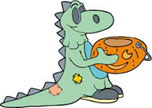 Fall Colors
Fall Colors
by April Falcon Doss
The trees are turning crimson, scarlet and golden in these last few weeks before the leaves drop to the ground and join all the critters hibernating for the winter. What makes the leaves change color? Why do they fall? How can you save a little bit of leafy color for the winter months ahead?
Why Leaves Change Color
All green leaves contain a chemical called chlorophyll that lets the tree turn sunlight into to helps the tree grow. But most leaves have, or can make, some other substances, too, and it’s these substances that decide what color leaves will be turn in the fall.
 As the days get shorter, trees make less chlorophyll, because there’s less sunlight for the chlorohpyll to turn into energy. When there’s less chlorophyll, some other chemicals start to show through: one set are carotenoids, and the others are anthocyanins. The carotenoids make plants — like corn, buttercups, and bananas — yellow. The anthocyanins make plants red or purple — like grapes, red apples, strawberries and plums. Tree leaves have carotenoids in them all summer long, and they start making anthocyanins in the fall.
As the days get shorter, trees make less chlorophyll, because there’s less sunlight for the chlorohpyll to turn into energy. When there’s less chlorophyll, some other chemicals start to show through: one set are carotenoids, and the others are anthocyanins. The carotenoids make plants — like corn, buttercups, and bananas — yellow. The anthocyanins make plants red or purple — like grapes, red apples, strawberries and plums. Tree leaves have carotenoids in them all summer long, and they start making anthocyanins in the fall.
As the trees make less chlorophyll, the yellow color of the carotenoids and the purple and red colors of the anthocyanins begin to show through in leaves that used to look green.
 Did You Know?
Did You Know?
Each kind of tree turns a particular color.
- Oaks turn red or brown or rust-colored.
- Dogwood trees turn purplish red.
- Red maples turn scarlet., sugar maples turn orange-red and black maples turn yellow.
- Some species, like elms, just turn brown.
Weather affects how brightly colored the fall leaves are.
- Warm, sunny days and chilly nights make for the brightest leaf colors.
- Leaves may change color later than usual if there’s been a late spring or a summer drought.
Why Do Leaves Fall?
Leaves would never be able to survive the freezing temperatures of winter. So trees seal off the veins that carry water to and from the leaves by building a layer of cells between each leaf and branch. Once the veins have been completely closed by the new cells, the leaves fall off.
 How to Save Fallen Leaves
How to Save Fallen Leaves
Pick a few of the prettiest fall leaves up off the ground. Make them into a leaf sandwich between two layers of wax paper. Cover the sandwich with an old towel or rag. Press the fabric with a warm iron, sealing the wax paper together with the leaf in between. If you want, you can cut the leaf shape out of the wax paper. Just be sure to leave enough room around the leaf that the wax paper edge stays sealed all the way around.
You can punch a hole in the wax paper and tie string through it to dangle the leaves in front of a window, or tie colored yarn to a bunch of wax-paper-preserved leaves and then tie the strings to a clothes hanger to make a leaf-mobile.
Kids Calander
 Thursday, October 31
Thursday, October 31
Happy Halloween
Have a haunting Halloween at Whole Foods Market. The store will offer trick-or-treating throughout the store, a costume contest for kids under age 11 and arts and crafts for kids in the cafe. Photos of the best costume winners will be posted on the community bulletin board. 3:30-5:30pm @ Whole Foods Market, Annapolis. Free:
410/573-1800.
Saturday, November 2
Alien Invaders
You’ve heard about the harm non-native animals can do to the environment, now learn about what non-native plants can do and what you can do to help keep them away. For ages 8-12. 2pm @ Patuxent North Tract, Rt. 198 between the BW Pkwy and Rt. 32. Free: 301/497-5887.
 Daily Drama
Daily Drama
The Annapolis Summer Garden Theatre teaches 11 to 16-year-olds how to audition, read without practice, improvise and more, in addition to playing theatre games. 1:30-4pm @ the Annapolis Summer Garden Theatre. $15: 410/268-9212, x 5.